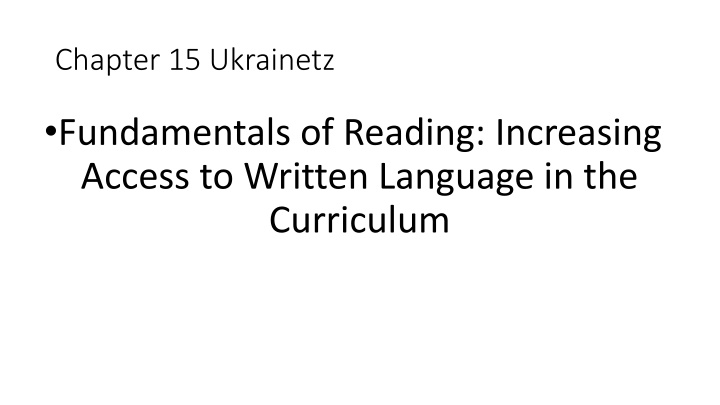
Improving Reading Fluency Through Word Identification Processes
Discover the key processes involved in enhancing reading fluency, including word identification strategies such as orthographic processing and phonological processing. Gain insights into the importance of automaticity in reading and its impact on comprehension.
Download Presentation

Please find below an Image/Link to download the presentation.
The content on the website is provided AS IS for your information and personal use only. It may not be sold, licensed, or shared on other websites without obtaining consent from the author. If you encounter any issues during the download, it is possible that the publisher has removed the file from their server.
You are allowed to download the files provided on this website for personal or commercial use, subject to the condition that they are used lawfully. All files are the property of their respective owners.
The content on the website is provided AS IS for your information and personal use only. It may not be sold, licensed, or shared on other websites without obtaining consent from the author.
E N D
Presentation Transcript
Chapter 15 Ukrainetz Fundamentals of Reading: Increasing Access to Written Language in the Curriculum
I. INTRODUCTION** We ve said before that 2/3 of the children who finish grade 4 reading below grade level end up in prison, receiving government assistance, or both 2/3 of children with oral language deficits also have difficulties with reading and writing Nearly 75% of poor readers in second grade have an early history of spoken language deficits
Without automaticity** The reader will not be able to focus cognitive energy on gaining the meaning of the text This is the ultimate goal of reading
III. PROCESSES INVOLVED IN WORD IDENTIFICATION A. Introduction--Review
For example** -ire (hire, tire, fire) Out-(without, outcome, outshine, lookout) -Ough (through, rough, though)
C. Phonological Processing (PP) (page 575)** PP involves perceiving, remembering, producing, and manipulating speech sound information 3 important aspects: RAN, phonological working memory, phonemic awareness
Phonemic awareness (what we have also called phonological awareness):
IV. STAGES OF READING DEVELOPMENT** (Challs stages) A. Introduction Please know the chart on page 578 thanks! Stage 0 prereading 0-5 yrs. Children are developing spoken language and phonological awareness Nursery rhymes and games are common Children begin to recognize very high frequency words as wholes (logographic reading)
(not on exam) Before kindergarten, most children can tell you what this says
B. Challs Stage 1: Initial Reading or Decoding Cracking the Code
Take a slappy hand and childrens book and go through the whole book: When the child lands the slappy hand on a word, they have to say each letter and sound in the word For example, if they land on some: It starts with the letter s which sounds like /s/ The next letter is o and sounds like /uh/ The next letter is m and it sounds like /m/ Etc.
In stage 1:** Orthographic reading (recognizing words automatically as wholes) Alphabetic reading (child analyzes the phonological system, applies knowledge of phonics) Logographic reading (visual stage--child memorizes the way a word looks and reads it without using knowledge of phoneme-grapheme correspondence)
C. Challs Stage 2: Confirmation, Fluency, and Ungluing From Print End of first grade, all of 2ndgrade
Sherman, H. The ASHA Leader Live.** She gave suggestions about how to support older students reading comprehension Before students read a difficult expository story, she shows a YouTube video to increase comprehension She also uses Simon s Cat videos to help students come up with the main idea She uses the website Baamboozle to help students verbalize the main idea while playing a free online game
From a 4thgrade science book: what are some Tier 3 words? Tier 2 words?
F. Challs Stage 5: Construction and Reconstruction
V. PRACTICAL TECHNIQUES FOR IMPROVING READING SKILLS A. Introduction
B. Incorporating Phonemic Awareness Into Phonics** (to review) Phonics: The letter R sounds like errr. Letter-sound correspondence. The letter C can sound like /k/ or /s/. (can, cup, Cindy, Celeste). (to review) Phonemic/phonological awareness: manipulate sounds (e.g., say fast without the /t/ )
Make rules explicit: ** When you see gh, the sound is /f/ (enough, tough, cough) The gh can also be silent (through, bough)
D. Other Practical Strategies for Improving Reading Skills
Associate a sound with an animal** /r/ is our tiger sound Zoo Phonics is a terrific program https://www.youtube.com/watch?v=PvbqYnwwaLw Zoo Phonics Signals and sounds with movement
Kyle, F.E., & Trickey, N. (2024). Speechreading, phonological skills, and word reading ability in children. LSHSS, 55, 756-766
Teach a few letters like m, s, t, l, a** Then have children make as many words as they can out of them Let s do this! Take the small cards I ve given you I ll give you one minute to make as many words as you can Write them down prizes to the winners!
Youtube video. Celeste Roseberry How to Improve Reading Fluency https://www.youtube.com/watch?v=j-rwf8vnKkQ
Group Activity** For the Galileo s Science passage, circle Tier 2 words Put a box around Tier 3 words






















